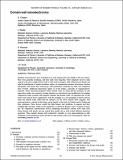Por favor, use este identificador para citar o enlazar a este item:
http://hdl.handle.net/10261/50958COMPARTIR / EXPORTAR:
 SHARE SHARE
 CORE
BASE CORE
BASE
|
|
| Visualizar otros formatos: MARC | Dublin Core | RDF | ORE | MODS | METS | DIDL | DATACITE | |

| Título: | Domain wall nanoelectronics |
Autor: | Catalán, Gustau CSIC ORCID; Seidel, J.; Ramesh, Ramamoorthy; Scott, James F. | Fecha de publicación: | 2012 | Editor: | American Physical Society | Citación: | Reviews of Modern Physics 84(1): 119-156 (2012) | Resumen: | Domains in ferroelectrics were considered to be well understood by the middle of the last century: They were generally rectilinear, and their walls were Ising-like. Their simplicity stood in stark contrast to the more complex Bloch walls or Néel walls in magnets. Only within the past decade and with the introduction of atomic-resolution studies via transmission electron microscopy, electron holography, and atomic force microscopy with polarization sensitivity has their real complexity been revealed. Additional phenomena appear in recent studies, especially of magnetoelectric materials, where functional properties inside domain walls are being directly measured. In this paper these studies are reviewed, focusing attention on ferroelectrics and multiferroics but making comparisons where possible with magnetic domains and domain walls. An important part of this review will concern device applications, with the spotlight on a new paradigm of ferroic devices where the domain walls, rather than the domains, are the active element. Here magnetic wall microelectronics is already in full swing, owing largely to the work of Cowburn and of Parkin and their colleagues. These devices exploit the high domain wall mobilities in magnets and their resulting high velocities, which can be supersonic, as shown by Kreines' and co-workers 30 years ago. By comparison, nanoelectronic devices employing ferroelectric domain walls often have slower domain wall speeds, but may exploit their smaller size as well as their different functional properties. These include domain wall conductivity (metallic or even superconducting in bulk insulating or semiconducting oxides) and the fact that domain walls can be ferromagnetic while the surrounding domains are not. 2012 American Physical Society. | URI: | http://hdl.handle.net/10261/50958 | DOI: | 10.1103/RevModPhys.84.119 | Identificadores: | doi: 10.1103/RevModPhys.84.119 issn: 0034-6861 |
| Aparece en las colecciones: | (CIN2) Artículos |
Ficheros en este ítem:
| Fichero | Descripción | Tamaño | Formato | |
|---|---|---|---|---|
| Domain wall nanoelectronics.pdf | 6,18 MB | Adobe PDF |  Visualizar/Abrir |
CORE Recommender
SCOPUSTM
Citations
990
checked on 16-abr-2024
WEB OF SCIENCETM
Citations
944
checked on 19-feb-2024
Page view(s)
393
checked on 26-abr-2024
Download(s)
1.818
checked on 26-abr-2024
Google ScholarTM
Check
Altmetric
Altmetric
NOTA: Los ítems de Digital.CSIC están protegidos por copyright, con todos los derechos reservados, a menos que se indique lo contrario.
